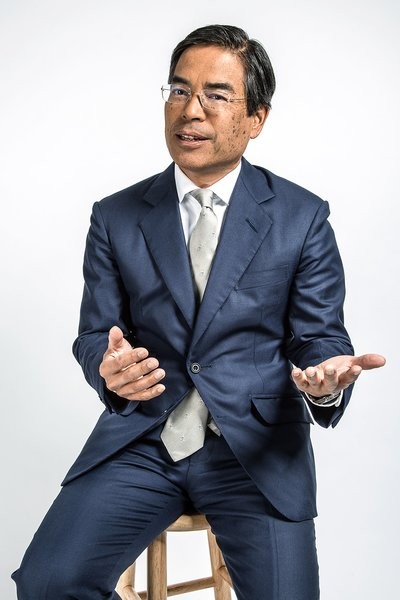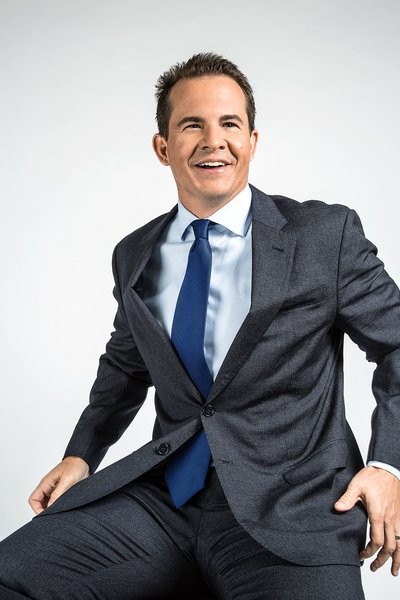《財富》邀專家談2018年投資建議
|
天下沒有不散的筵席。雖然有史以來持續最久的牛市幫投資者今年又賺了不少,但很多人腦中這個想法都揮之不去。經濟持續向好,技術革新性變化也讓很多公司回報可觀,是不是該認真從一群普通股票中選出潛力股?為了回答這個問題,《財富》在即將進入2018之際特地邀請投資專家召開了年度圓桌論壇。 今年的與會者包括美國普信集團股票和多種資產首席投資官大衛·吉諾斯,掌管450億美元資產;新時代投資公司董事總經理兼投資組合經理凱拉·范瓦倫,該公司管理資產規模為490億美元;管理45億美元資金的跨國風投公司柏尚投資合伙人拜倫·迪特爾;管理190億美元資產;還有美銀弗雷德·艾爾格管理咨詢公司首席執行官兼首席投資官丹尼爾· 鐘;美林全球研究團隊美國股票和量化投資策略負責人薩維塔·薩布拉瑪尼安,管理客戶資產總值高達2.7萬億美元。以下為各位嘉賓討論內容節選。 《財富》:我想問問當前的股市長牛。當前的牛市已經持續近九年,包括我自己在內,不少唱衰者都在擔心市場估值泡沫問題,尤其是美國市場。2018年有沒有可能出現調整? 薩維塔·薩布拉瑪尼安:確實有點讓人不安。如果股市堅挺到明年7月還不跌,我們真會迎來史上持續時間最長的牛市。現在買入感覺確實不好。 但如果想想1999年的情況,當時估值也很高。一個版塊撐起了標普500大部分收益。當時也是感覺不適合買入,但當年卻是那輪牛市里收益最高的一年。 看來估值真不適合用來判斷市場時機。如果你太擔心接下來一年(所以不敢投資),那么用市盈率來計算市場回報就是接近零。 |
Every party has to end sometime. That’s the troubling thought that’s been nagging at many investors this year, even as they’ve continued to profit from one of the longest-running bull markets for stocks in history. Positive economic trends and transformative changes in technology are helping many companies deliver standout returns—but is it time to get choosier about sorting winners from losers? To answer that question as we roll into 2018, Fortune convened our annual roundtable of investment experts. This year’s panel included David Giroux, chief investment officer for equity and multi-asset at T. Rowe Price and manager of a $45 billion portfolio; Kera Van Valen, managing director and portfolio manager at Epoch Investment Partners, a firm with $49 billion under management; Byron Deeter, partner at Bessemer Venture Partners, a global VC firm with $4.5 billion under management; Dan Chung, CEO and chief investment officer of the $19 billion Fred Alger Management advisory firm; and Savita Subramanian, head of U.S. equity and quantitative strategy at Bank of America Merrill Lynch Global Research, whose wealth-management client balances total $2.7 trillion. Here, edited excerpts from their discussion. FORTUNE: I’d like to ask about the very long bull run that we’ve had in stocks. The bull market is almost nine years old. Some Cassandras, myself included, have been worried that markets are overvalued, especially in the U.S. Is a slowdown or even a market correction looking more likely in 2018? SAVITA SUBRAMANIAN: It does feel sort of unsettling. By next July if the market continues to go up, we’ll be in officially the longest bull market, by technical definitions, in history. And it doesn’t feel good to buy equities now. But if you think about 1999, it was a year where valuations were getting high. One sector was driving most of the returns of the S&P 500. It didn’t feel great to buy equities, yet that was one of the best years of that bull market. It also turns out that valuations are a really lousy market-timing model. If you’re concerned about what happens over the next 12 months, the amount of returns that are explained by the price/earnings ratio are basically close to zero. |

|
《財富》:你提到1999年讓我想起,過去一年市場上表現最好的版塊跟1999年一樣,都是科技股。但是丹,你又說過從歷史角度看當前科技股估值并不算高。 丹尼爾·鐘:如果看20年來各版塊的市盈率中位數,即便偶爾冒進過,但科技和醫療股價格基本上接近市盈率中位數。溢價比較高的版塊實際上是材料、公用事業、大宗商品和工業股,比起中位數溢價比例介于14%到20%。所以真正算下來,科技和醫療股的估值還算合理。 拜倫?迪特爾:去年經歷了一些大事件,我覺得能證明當前科技行業的業績有支撐。 7月,全球市值排名前五的公司都是風投支持的科技公司,包括蘋果、谷歌母公司Alphabet、微軟、亞馬遜和Facebook。順便說下,排名第六的中國公司阿里巴巴也是風投支持的科技公司。強勁業績支撐下的各家巨頭市值超過了傳統大公司伯克希爾、摩根大通和埃克森,成為全世界價值最高的企業。 再想想未來的發展趨勢——移動化、機器學習,以及云計算。以后這些新領域將成為拉動經濟發展主要動力,而且趨勢會一直持續。 凱拉?范瓦倫:當前市場由量化寬松推動轉為看實際基本面,看利潤增長,看現金流增長如何推動市場。我們認為這種趨勢會持續下去,所以認為不會出現什么調整。 《財富》:大衛,有沒有資產估值高到讓你擔心? 大衛·吉諾斯:現在不管看全球哪里估值都很高,而且息差都在收窄。國債利率也很低,所以沒什么特別好的投資標的。 一般來說,外國股票比美國便宜些,但如果穿透表面看本質,剔除FANG四大股(Facebook、亞馬遜、Netflix和谷歌)之后,歐洲股票跟美國股票估值比較接近。 我們很喜歡醫藥之外的醫療板塊。這類股票市盈率基本在1.5到2倍之間。所以可以看一些研發生命科學工具的公司,例如珀金埃爾默,或賽默飛世爾科技。兩家都在中國有不少業務。想想現在推動中國經濟增長的是哪些因素,醫療、食品安全,還有水質。這些領域的產品都是生命科學公司可以銷售的。 《財富》:科技公司其實也能參與一些。 鐘:是的。舉例來說,我認為醫藥和生物科技…哦,我想不起來人類基因哪年完成測序了,之后進展非常迅速,測序技術也變得非常便宜,也為現在研發新藥奠定了基礎。例如在免疫腫瘤學領域:其實并非所有的癌癥腫瘤都一樣,基本上說,根據基因差異可以判斷哪種癌癥會對哪些藥物有反應,哪些不起作用。當然了,應用范圍也不只是癌癥。囊性纖維化(制藥公司)Vertex在治療方面就進展迅速。 設備方面,我們比較欣賞Illumina,這是家基因測序公司,其產品在分析基因編碼和測序信息作用很大,可供治療和研究使用。軟件和自動化也在推動進展。Intuitive Surgica之類業內很成功的公司使用自動化技術越來越多,可以對手術過程實施更嚴格的控制,減少對健康組織和神經的傷害,也可以降低腫瘤的侵襲性。 《財富》:談談稅改吧。我們一直在討論產品銷往全世界的美國公司。大家都知道,很多跨國公司的利潤都放在海外。如果稅改方案通過,很多現金會流回美國,會不會有更多流向股東? 范瓦倫:一次性現金變化,或稅改本身都不太可能增加資本投資,因為近年來獲得融資相當容易。所以一次性事件不太可能改變現狀。我們預計實質性影響更可能通過股票回購體現。如果稅改或減稅可以確定,即便公司不改變資本分配政策,但由于利潤增加,股息同樣可能提升。 迪特爾:稅改政策是可能有些實質性的積極影響。但我更關心移民政策。數據顯示市值超過10億美元的科技公司里有51%至少一位創始人是移民。如果遣返或限制移民,創新經濟會遭受災難性的重創。 |
FORTUNE: You invoked 1999: One of the better performing areas of the market in the past year has been, once again, technology. But, Dan, you were saying that tech valuations, relative to history, are not that high. DAN CHUNG: If you look at the 20-year median P/Es of each sector, even with the run that they’ve had, technology and health care are basically trading at their median P/Es. The sectors that are trading at premiums are actually materials, utilities, staples, and industrials, where they’re somewhere between 14% and 20% premiums to their medians. So by that measure, technology and health care actually remain reasonably valued. BYRON DEETER: We passed some major milestones last year that I think speak to the fundamental performance of these tech businesses. In July, the five largest market cap companies on the planet were all venture-backed tech companies, including Apple, Alphabet, Microsoft, Amazon, and Facebook. No. 6, by the way, is Alibaba, also venture-backed technology, in China. The fundamental business performance of these companies has allowed them to pass the old guard of Berkshire, JPMorgan, and Exxon for the world’s most valuable companies. And as you think about the trends ahead—mobility, machine learning, cloud computing—a lot of these tailwind trends that are ripping through large portions of the economy are increasing and going to continue. KERA VAN VALEN: We’ve also moved from a market that’s been fueled by quantitative easing to one where it’s actual fundamentals—earnings growth, cash flow growth—that have driven the markets. We think that can continue, so we’re not looking for a correction by any means. FORTUNE: David, do valuations in particular asset categories worry you? DAVID GIROUX: Globally, wherever you look, valuations are high and credit spreads are kind of tight. Treasury interest rates are kind of low as well, so there’s no real good value. Foreign stocks are nominally cheaper than U.S. stocks, but really when you look under the surface and take out the FANG stocks [Facebook, Amazon, Netflix, and Google], European stocks and U.S. stocks are somewhat similarly valued. I would say the one sector that we like a lot is non-pharma health care. You’re getting companies basically running at a market multiple with 1.5 to 2 times the growth rate of the market. So you think about something like the life science tool companies, like a PerkinElmer (PKI, +0.45%), or Thermo Fisher Scientific (TMO, -0.02%). They have a lot of exposure into China. And you think about what’s driving China’s growth rate, it’s health care, food safety, water quality. These are things that all the life sciences companies sell into. FORTUNE: That is in some ways a technology play too. CHUNG: Right. I think in pharma and biotech, for example, you’ve got, oh, I don’t know how many years ago the human genome was sequenced and then the development of ever faster, ever cheaper sequencing techniques. That set the base for research that is now coming out with new drugs. For example, immuno-oncology: Cancer tumors are not all the same, basically, and genetic differences can determine what cancers respond to which drugs and which do not. And it’s not just cancer, of course. Cystic fibrosis [drugmaker] Vertex (VRTX, -0.52%) has shown pretty remarkable advances there in treating that terrible disease. On the equipment side, we like Illumina (ILMN, -0.65%), which is one of the genetic sequencing companies that provide the heavy horsepower to analyze specific genetic codes and sequences for clinical and research purposes. There are also advances that are software and automation driven. So a great company like Intuitive Surgical is using more and more automation software to allow surgery to be done with more control, less damage to healthy tissue or nerves, and less invasiveness. FORTUNE: Let’s talk about tax reform. We’ve been talking about American companies selling their products worldwide. And as we know, they’re parking a lot of their earnings overseas. If tax reform passes and a lot of that cash comes back to the States, does more of it flow to shareholders? VAN VALEN: It’s unlikely that any one-time cash change, or any tax reform per se, is going to increase capital investments because access to funds has been quite easy in recent years. So a one-time event shouldn’t change that. We would expect it potentially to materialize more through share buybacks. If there’s a permanent level to the tax reform and tax reductions, then dividends could increase even without companies having to change their capital allocation policies because they would be more profitable. DEETER: There are some real potential positives from tax policy. In terms of immigration policy, I’m a little more concerned. The data shows that 51% of companies in the tech sector with over a billion dollars in market cap were started by at least one immigrant founder. If you throttle that back, or if you start to limit immigration, there will be disastrous impact on the innovation economy. |

|
薩布拉瑪尼安:說得非常對。科技領域對H-1B簽證最為敏感。所以,移民政策動向對科技板塊來說是重大風險。 《財富》:如果移民政策風險真的爆發,美國遭受損失的同時誰會獲益呢? 薩布拉瑪尼安:如果看股市的話,可以多關注美國國內股票,看看主要雇傭美國員工的企業。不過我認為最終會導致通脹,也有可能引發滯脹,因為沒法再享受海外人才帶來的增長。 鐘:我認為投資者會更多關注中國。中國的科技行業先進程度跟美國差不多,又在向“一帶一路”計劃大手筆投資建基礎設施。如果美國真的撤出全球化,拒絕移民,中國會成為資本集中開展各種項目的地方,也能吸引到人才。 我還要提出的一點是,中國的騰訊等科技公司在移動支付方面遙遙領先西方同行,也超過了歐洲標準。 吉諾斯:去年我在華盛頓特區待過很久。我覺得稅改會真正實行,而且對美國市場有好處,因為目前公司稅平均水平約為27%。稅改后可以降到20%,由此可以推動利潤上升,沒準能漲7%,8%,9%。美國國內公司、金融機構和消費品公司都有可能獲益。 所以你看,現在輝瑞之類公司稅率為34%,如果稅改方案通過輝瑞的利潤可能每股多出億美元。再看飲料公司胡椒博士(Dr Pepper Snapple),現在稅率也是34%,股價比起以往一直有折價,如果稅改通過利潤可能最多提升15%。現在有很多高賦稅的公司估值都沒有(根據稅改影響)調整到位。 《財富》:以前有說法是大規模減稅后,小公司獲益更多。 薩布拉瑪尼安:確實是這樣。小盤股有效稅率更高。一旦減稅小公司收益會更多。但挑選小盤股時也要小心,問題在于公司實際能從減稅政策中獲益多少?我們發現某一板塊或整體市場都享受到降低公司稅之后,很多成效其實都在競爭中磨掉了。 舉個例子,如果你在一個非常市場化的行業里,你跟所有競爭對手同時享受到減稅待遇,或許你可以通過降價傳導給顧客,但競爭對手同樣可以降價,減稅帶來的邊際效益也就基本消失了。 |
SUBRAMANIAN: That’s absolutely right. Tech is the most exposed to H-1B visas of any sector. So, yeah, that is a big risk for the tech story. FORTUNE: If that risk comes to fruition, who gains if the U.S. loses? SUBRAMANIAN: In stocks, you’d want to go domestic; you’d want to go for U.S. companies that hire primarily U.S. workers. I think that’s ultimately inflationary and potentially stagflationary, because we’re crimping off growth from overseas. CHUNG: I think China would be in a very strong position for investors. Their Internet industry is just as strong as the U.S. They’re making huge investments in the Silk Road initiative for infrastructure. And if the U.S. is really withdrawing from globalization and immigration, they are a source of capital as well for all of these projects, as well as talent. And I would point out companies like Tencent (TCEHY, -3.15%), where in mobile payments they’re well ahead of Western or even European standards. GIROUX: I actually spent a lot of time in D.C. over the last year. I think you will see tax reform. I think it’s a positive for the U.S. market because the average company today is at about a 27% tax rate. If that can go down to 20%, that could boost earnings for the market, 7%, 8%, 9%. The domestic companies, financials, consumer discretionary companies would probably be the winners. So if you look at a company like a Pfizer (PFE, +1.08%) that has a 34% tax rate, their earnings could potentially go up as much as a dollar a share if you had tax reform. You could look at a Dr Pepper Snapple (DPS, -0.38%) with a 34% tax rate, where their earnings—it was actually trading at a discount to what it historically traded, where the earnings could go up 15%. There are a lot of high-tax-rate companies that are just not being appropriately valued for [the impact of a tax cut]. FORTUNE: Historically it’s been argued that a big tax cut benefits smaller companies more. SUBRAMANIAN: It’s true. Small-caps pay a higher effective tax rate. They would stand to gain a lot more from that tax cut. But within small-caps you need to be careful because the question is, How much of that tax benefit are companies going to actually retain? And what we’ve found is that when you have a windfall for a sector or for the market overall from a lower corporate tax rate, a lot of that benefit is actually competed away. So for example, if you’re in a commoditized industry and you and all of your competitors get a windfall in terms of a lower tax rate, maybe you pass that on to your customers through lower prices, and that marginal benefit actually gets whittled away by natural competitive forces. |

|
《財富》:稅改過后2018年會不會涌現IPO潮? 迪特爾:很有可能。現在的市場狀況非常詭異,可以稱之為獨角獸上市堰塞湖,大量高質量公司選擇推遲上市。八年前第一次出現風投支持私人科技公司估值超過10億美元。現在全世界超過了200家,其中多過半數在美國。 所以現在有大量優秀的公司,高質量的公司等著上市,例如估值上百億美元的Ubers、Airbnbs和Pinterests,還有數十家估值遠超10億美元的企業云公司,要是前些年肯定已經上市了。 私下里我也知道有些公司在做準備,如果市場能維持穩定2018年初就啟動上市,但要等到一季度結束或二季度開始,這樣能把2017年全年審計財報數字加進去。現在只需要一點穩定性——振幅低的市場和愿意買入的投資者。 《財富》:在你看來,明年新技術可能帶動哪些特定行業? 迪特爾:用不了幾年汽車行業就會徹底轉型,主要受三大趨勢影響:電動、按需,而且很快會出現無人駕駛。我認為現在美國的孩子們長大不會再考駕照,開車可能會成為一種愛好,就像現在的騎馬一樣,因為人類駕駛很不理性也不安全。 《財富》:你認為傳統汽車制造商能跟上趨勢么? 鐘:跟不上。傳統汽車公司仍然會參與競爭,會被動跟著潮流走,但領頭羊顯然會是特斯拉、谷歌(和母公司Alphabet)、Uber之類公司,如果蘋果積極加入也有可能加入領先之列。關鍵是,車上可能還貼著通用汽車的標志,按如果自動駕駛技術要通過別家公司許可,如果得外包更先進的電子設備,那么汽車的核心價值很可能逐漸流向科技巨頭,而不會留在通用汽車。 迪特爾:我想補充一點,現在有很多汽車公司花費數十億美元想跟上自動駕駛和電動汽車潮流。所以還是要鼓勵下通用汽車、福特和戴姆勒。傳統巨頭們都在拼命學習,也在內部加強投資。 《財富》:談談通脹吧。美聯儲表示將繼續收緊利率,可能對稍稍推動工資增長。你們的戰略會受什么影響? 范瓦倫:五年前我們就在討論利率上揚如何應對,現在終于迎來利率上升反而有些解脫。 利率上行確實會有影響,即便是人人都認為面臨挑戰的公用事業版塊也是一樣。2015年利率剛往上走的時候公用事業版塊跟標普500指數基本符合,稍微好一點。所以要選準公用事業公司,不要只盯著高收益的公司,要找真正有現金流,而且增長率能支撐公司回饋股東的。我們認為只要能如實反映經濟增長,利率上升的環境其實利大于弊。 雖然公用事業版塊也受益于技術發展,例如智能電表應用。智能電表意味著如果遇到暴雨不再需要那么多員工出外勤,也不用在街上開車巡視,看哪里樹倒了壓倒電線,因為通過智能電表立刻就能知道。PPL就是個例子,這家公司目前在投資更換智能電表改造電網,提升電網適應能力。智能電表計劃會推動費率基準、利潤和現金流增長,最終也會提振股息。 薩布拉瑪尼安:美聯儲一直在印鈔,通常會導致通脹出現,但并沒有出現。 有個有趣的趨勢,我們發現美國在體力崗位上勞動力缺乏日益嚴重。舉個例子,工業分析師和交通分析師都寫到,很多公司找不到體力勞動工人。原因還挺特別。因為很多人對阿片類藥物上癮,能工作的人數大為減少。體力勞動者坐牢的比例也更高。我們還發現適合工作的體力勞動者,尤其是男性工人都在沉迷電子游戲。 勞動力缺乏也體現在利潤方面。舉個例子,建筑商為了把工人從其他活動上拉回來就得付更高工資。這是個剛開始出現的趨勢,慢慢人們會發現此類行業利潤會受到影響。 最核心的問題是就是公司能不能掌控定價能力,經濟能否保持強勁,消費者才愿意付更高價錢抵消成本上升。 |
FORTUNE: Could tax reform turn 2018 into a big IPO year? DEETER: Quite possibly. We have this very bizarre market dynamic right now, which you can call the logjam of the unicorns, the unpre?cedented number of high-quality companies that have chosen to delay their IPOs. Eight years ago was the first time a venture-backed private tech company was valued at over a billion dollars. We have over 200 today worldwide, and well over half those are in the U.S. And so you’ve got this glut of fabulous companies, high-quality companies that in prior years would have been public, and today are sitting on the doorstep with ranges from the Ubers and Airbnbs and Pinterests in the tens of billions to dozens of enterprise cloud companies that are worth well over $1 billion. I know of several companies personally that are targeting early 2018 IPOs if the market holds up, but are waiting until late Q1 or early Q2 so that they can include their full 2017 audited financials. We just need predictability—low volatility and willing buy-side investors. FORTUNE: What are some of the specific industries where you’ll see new technology moving the needle next year? DEETER: Automotive a few years from now will be completely transformed by the three big trends: electrification, on demand, and soon, autonomy. I don’t believe kids born today in the U.S. will get their driver’s licenses, and it will seem like a hobby to drive a car, much like riding a horse is, because it’s irrational and unsafe. FORTUNE: Do you think the legacy automakers can keep up? CHUNG: They cannot keep up. They’re going to play because they can be late followers, but the leaders are clearly going to be companies like Tesla, Google [and its parent Alphabet], Uber, and we’ll see if Apple still is playing in the automotive field. And the important part, I mean, the car may say GM on it, but if they have to license the automated driving technology from somebody else, if they have to purchase better electronics from the outsource, then the value in the car might increasingly go to the technology leaders as opposed to GM. DEETER: I would just add there’s over a dozen automotive companies spending over a billion dollars each toward the combination of this autonomy and electrification wave. And so I give GM, Ford, and Daimler some credit. They’ve been acquisitive but also have invested internally. FORTUNE: Let’s talk about inflation. You’ve had the Federal Reserve signaling that it’s going to continue to tighten interest rates, and you’ve had some wage growth that might move the needle a little bit. How is that affecting your strategy? VAN VALEN: We’ve been talking about when interest rates will rise for five years now, so it is a little bit of a relief to actually be in an environment where interest rates are rising. That’s true even for sectors like utilities, which everyone assumes will be challenged. Utilities have performed in line or better than the S&P 500 since the first interest rate hike in 2015 here in the U.S. So as long as you’re focusing on the right utilities, not just high-yielding companies, but companies that actually have the cash flows and the growth to support their cash returns back to shareholders, we think that the rising interest rate environment is actually a good thing as long as it is a reflection of improvement in the economy. And even the utilities sector is benefiting from technology, for example with smart meters. Smart meters mean not having to employ as many people to go out when there’s a storm. You don’t have to drive around the block to figure out where the tree fell that knocked down the power line because the smart meter can tell you this immediately. PPL (PPL, -1.68%) is an example of a company currently investing in a smart-meter replacement project that is modernizing the power grid to make it more resilient. This smart-meter project does contribute to the rate base, earnings and cash flow growth, which ultimately helps drive the growth in the dividend. SUBRAMANIAN: The Fed has been printing a lot of money, and normally you see inflation alongside that. And we haven’t. One interesting trend that we’re noticing in the U.S. is this growing scarcity of labor within more manual-labor-oriented jobs. So for example, our industrials analysts, our transports analysts have been writing about the fact that these companies can’t find manual labor types of workers. And the reasons are pretty unusual. There is a larger percentage of people addicted to opioids, and that’s shrunk the pool of available workers. There’s a higher incarceration rate. And we’ve also noticed that the average, you know, typically male members of society that sign up for these jobs are playing more video games. But this scarcity is actually showing up in margins. So you’re seeing homebuilders, for example, having to pay higher and higher wages to court these workers back from other activities. It is a trend that’s just starting to percolate, and you are starting to see margins in those industries under some pressure. The million-dollar question is whether they will have pricing power, whether the economy gets strong enough that consumers are willing to pay the higher prices that offset the cost increase. |

|
《財富》:說到付更高價格,我非常想談談亞馬遜效應,不僅在零售方面,也包括其涉足的各個領域。 吉諾斯:馬特。我覺得這個問題比亞馬遜效應要大得多。我做這行已經19年了,從來沒見過現在這么多顛覆。我們談了一點無人駕駛汽車,對通用汽車或福特會有什么影響。也可以想想頁巖油。頁巖油確實顛覆了OPEC還有能源大佬們。 我們還可以從技術角度談談區塊鏈怎么顛覆資金轉賬,影響未來的保險公司。幾乎每個領域都在發生變化。如果有領域沒變化,我猜過段時間業內公司的估值也會比過去提升。 鐘:市場上確實有這種趨勢,消費領域公司借用亞馬遜模式就能做得好些,至少風險會低一點。明顯的例子就是電子游戲公司,行業里有些著名品牌例如Take-Two Interactive和動視暴雪。但這些業務其實亞馬遜做不了。 另一個例子是演唱會推廣公司萊恩公司,主要做現場娛樂活動;旗下有特瑪捷票務公司,還有場地表演和音樂節,所以有獨特的廣告機會,主要針對千禧一代年輕人。仔細想想就知道,這些都是人們珍惜的體驗機會,但沒法通過亞馬遜實現。全食超市也是個明顯的反例,是吧?亞馬遜已經直接殺入非常傳統的實體業務領域。 范瓦倫:這就是私人公司能凸顯自己特色的機會。舉供應商金寶湯為例,會員店造成了顛覆,美國有量販超市好事多,還有遍布全球的山姆會員店。不能任由超市里打包賣六罐湯贈送點塑料容器,還享受折扣。利潤肯定會受影響。所以金寶湯之類公司要坐下來仔細想想,怎樣才能適應好新環境?如何采用不同的包裝方式,提供不同的折價點,一方面確保零售商能賺到錢,另一方面也要想辦法直通消費者。 所以現在改變的不只是零售業,消費者也在變,購物方式也在變。所有變化交織在一起,但從公司層面來看確實承受了很多壓力,不僅要適應,還得迅速適應。在積極利用新技術迅速轉變方面有個好例子,就是麥當勞。麥當勞一直在采取最新的技術手段,例如全球各地上線手機應用,還有店內電子點餐臺,顧客購買和支付都由更多選擇。此外,麥當勞還開始跟UberEats合作提供送餐服務。 《財富》:最近看到一些石油方面的新聞,例如委內瑞拉和沙特,要是五六年前油價可能會一飛沖天。但現在油價十分平穩。油價保持在55美元到65美元一桶會不會成為新常態? 吉諾斯:事實上我想說,五年前油價比現在低多了。現在我們有頁巖油及時供應。可以隨時打新井,三個月就能產油。由于業內巨頭遭受巨大打擊,回應方式就是減低成本,新出的海洋石油價格降到40美元到50美元,過去價格得到70美元,80美元才能多賺錢。 這里還要提一下無人駕駛和電動汽車。長遠來看,對能源的需求是在降低的。所以當前是低成本且需求逐漸減少的情況下增加供應。如果你是長期投資者,那么未來五到十年降低能源投資比例比較明智。 鐘:天然氣價格很低,而且維持了一段時間。天然氣在美國也是頁巖油的副產品,可以滿足大部分電器需要,是吧?天然氣加上可再生能源是影響全球能源價格的重要因素。所以長期來看我們是偏負面的。 迪特爾:電池技術方面會有大筆投資,特斯拉市值很大一部分都是跟電池工廠Gigafactory相關的。由于跟中國競爭者打價格戰,美國風投行業確實在太陽能電池上虧了些錢,但長期來看這個市場很大,不容忽視。 《財富》:所以看2018年的話,最大的風險在哪,最大的機會在哪? 迪特爾:我覺得最大的風險在地緣政治,涉及剛剛談到的稅改和移民政策,還有國際政局能否穩定。不過我認為經濟和商業基本面還是比較強的。 機會方面,我們剛才對科技是經濟發展主要推動力也談到很多。技術領域內軟件是最重要一部分,軟件發展的未來就是云計算。所以從公司層面看到話,我們非常看好云計算。2016年云通訊公司Twilio上市,最近SendGrid也上市了。我認為2018年趨勢推動下行業發展會更迅速。 《財富》:薩維塔,你怎么看? 薩布拉瑪尼安:過去40年我們都習慣了低借貸成本,杠桿幾乎免費,現金沒什么收益,很快就要結束了。隨著美聯儲收緊利率,情況會發生變化,說起來有點復雜,尤其是看標普指數里有些很像債券的股票。市場中有些領域在經濟下行時表現不錯,例如公共設施建設,但如果下行趨勢由利率上升導致,可能表現也不會多好。 我覺得消費品版塊里互聯網和郵購可能不錯,有些過氣的實體零售店可能會繼續一蹶不振,可能還會繼續走低。 《財富》:丹,你認為呢? 鐘:看到大筆資金流入指數、指數基金、量化投資策略,還有電腦導致的閃電崩盤,我其實有點擔心。不一定會長期存在,但可能會出現劇變,有點恐怖。知道么,現在指數基金比場內交易的股票還多。股票最大的買家是本公司,因為現金流非常充足。所以供求嚴重失衡,我擔心羊群效應下量化催動的資金能否理智。 我們對科技行業還是很樂觀,包括軟件、云計算以及軟件即服務。各家公司都在適應數字世界。錢很多,但勞動力很缺。科技行業的人才很貴,所以現在公司應該多投資提升效率,為新一波商業革新做好準備。 我們最擔心的是定價能力不足,增長又比較緩慢的公司。消費行業很多公司基本面都不太好。其實都是些歷史悠久的公司,但千禧一代都不再感興趣。我們也分析了服裝和零售。很多過去的名牌現在你女兒并不喜歡。 |
FORTUNE: Speaking of not paying higher prices, I have been dying to talk about the Amazon effect, not just on retail but on all kinds of industries where it competes. GIROUX: Matt. I think it’s much more broad than the Amazon effect really. I’ve been doing this for 19 years. I’ve just never seen more disruption in more sectors than I do today. We’ve already talked a little bit about autonomous cars, what impact that could have on GM, Ford. Or think about shale oil. Shale oil is really disrupting OPEC and the energy majors. We talk about watching blockchain, from a technology perspective, disrupting money transfers or title insurers down the road. Almost every sector out there is going through some change. And those sectors that are not, my guess is over time those companies’ valuations will tend to go higher than they have historically. CHUNG: There’s definitely been a trend in the market where companies in the consumer space fare better if they are Amazon-proof or at least seem less subject to risk. A great example is the video game companies. The industry has significant franchises like Take-Two Interactive (TTWO, -0.66%) and Activision Blizzard (ATVI, +1.99%). It’s not a skill set that Amazon has. Another example is Live Nation (LYV, -1.56%), which is in the business of live entertainment; they own Ticketmaster, and they also own venues and music festivals, which gives them unique advertising opportunities, especially with millennials. If you think about it, these are experiences that people value, and they’re not Amazon-able. And Whole Foods is the most dramatic counterexample, right? Amazon has moved directly into one of the most brick-and-mortar businesses that there is. VAN VALEN: This is where the individual companies are going to have to distinguish themselves. Take suppliers like Campbell’s Soup (CPB, +2.47%), for example. They had a disruption from club stores, the Costcos and the Sams of the world. You couldn’t just take six cans of soup and add some plastic around it and sell it for cheaper. That obviously would hurt your margins. So companies like Campbell’s have had to sit down and figure out, How do we operate within this new environment? How do we offer different packaging, different price points to make sure not only can we help the retailers survive, but also figure out how to get direct to consumers. So it’s not just the changing retail, it’s also the changing consumer, and the consumer shopping differently. It’s all intertwined, but there’s certainly a lot of pressure on these companies to adapt and adapt quickly. An example of a company that has embraced technology and, therefore, adapted is McDonald’s (MCD, -0.59%). They continue to deploy technology solutions like their global mobile app and in-store kiosks, which ultimately give people more choice on how to order and how to pay. In addition, they have begun to partner with UberEats to offer delivery. FORTUNE: Recent news we’ve seen from oil producers like Venezuela and Saudi Arabia have involved the kinds of events that five or six years ago would have sent oil prices through the roof. Instead they’ve been relatively stable. Is oil in the $55-to-$65-a-barrel range the new normal? GIROUX: Actually I would argue that in five years oil will be dramatically lower than it is today. Today we have basically just-in-time production on shale. You can drill a new hole and actually have oil producing in three months. And as the majors have been disrupted by that, they’re responding by lowering their cost to be able to bring on new production offshore at $40 to $50, where they used to need $70, $80 to get good returns. And again, we have to talk about autonomous vehicles and electric vehicles. Long term, the demand side of the equation for energy is also at a negative. So you have more supply at lower cost as well as declining demand. If you are a long-term investor, it makes a lot of sense to be underweight energy in the next five to 10 years. CHUNG: Natural-gas prices are very low and have been for a while. It’s also a by-product of the shale revolution in the U.S. Natural gas is what powers most of our electricity needs, right? And that combined with renewables is another important trend that will affect energy prices globally. So we also have a negative long-term view. DEETER: Battery technology continues to see heavy investments, and a large portion of Tesla’s market cap is actually Gigafactory related. The U.S. venture capital industry did lose money in solar as a result of the aggressive pricing from Chinese competitors, but the size of the market is too large to ignore long term. FORTUNE: So for 2018, where do you see the greatest risk and the greatest opportunity? DEETER: I think the biggest risk is geopolitical, both with tax and immigration policy, which we talked about, as well as international political stability. But I think the fundamentals of the economy and the businesses within the economy are quite strong. On the opportunity side, we’ve talked a lot about how tech is the largest sector of economic growth. Software within tech is the biggest driver, and cloud computing is the future of software. And so as a firm, we have disproportionately bet on cloud computing. We took Twilio (TWLO, +1.93%) public in 2016, and SendGrid (SEND, -3.03%)just [recently]. And I think 2018 is very much a double-down year where that trend is going to accelerate even more. FORTUNE: Savita, what’s your thinking? SUBRAMANIAN: We’re at the end of a 40-year period where we got used to a very low cost of capital, where leverage was essentially free and cash yielded nothing. Moving from that scenario to an environment where the Fed is tightening, that’s going to be a little bit tricky, especially if you look at valuations of some of the most bond-like stocks in the S&P. There are areas of the market that typically do well in a downturn, like regulated utilities, that might not do as well in a downturn if that downturn is caused by a rate spike. I think within the consumer discretionary sector, the Internet and catalog retailers might win, and some of the bombed out brick-and-mortar retailers might remain bombed out and even go lower. FORTUNE: Dan, what do you think? CHUNG: I’m a little worried about the massive amount of money that’s flowed into index, ETF, and quantitative-oriented strategies, and the chance of a computer-driven flash crash. It wouldn’t necessarily be something that is very long-lasting, but could be sharp and kind of scary. You know, there are now more ETFs than there are stocks. And companies are actually their biggest buyers of their own stocks because of their strong cash flow. So there’s been a real imbalance in supply-demand, and I worry about what all that quantitatively driven money will do if it tends to be herd-like. We’re definitely most optimistic about tech—software, cloud computing, software as a service. Companies generally are adapting to the digital world. They have the money. Labor is scarce. Talented technology employees are very expensive, and so it’s exactly the right time when companies invest in these things to improve their efficiency and also to bring themselves into the next wave of business. What we’re the most concerned about is actually low-growth companies without a lot of pricing power. We think a lot of the consumer staple names are not in good fundamental position. They are beloved historic companies, but they are just not the brands or the products that the millennials are interested in. Our analysis on that extends into apparel and retailing as well. They’re not your daughter’s fashion brand. |

|
《財富》:凱拉,你覺得最大的風險和機會分別在哪? 范瓦倫:我不是很擔心利率上升,或是升得快,即便真發生對一些防御性更強的領域也不會造成太大傷害。反正所有領域都會受到打擊。 至于機會方面,我們認為技術是新的宏觀面。在科技行業按股息水平選股不太容易,但技術對各個領域收入增長和利潤水平的影響巨大。我的意思是利潤可能會保持高水平。也就是說現金流可能會很高,所以股東能享受更多回報。 《財富》:大衛,總結一下? 吉諾斯:過去五年復合增長率在5%左右。如果2018年真能實現稅改,利潤增長率可能達到13%到15%,具體情況要看公司稅怎么改。我認為總體來說市場情況向好,也會推動利潤增長。 負面因素方面:如果看未來三到五年,現在的價值水平比較高。我也不清楚2018年會不會調整,但既然身處周期里相對高位,還是保守些比較穩妥。 《財富》:非常感謝各位。很榮幸能邀請各位來參加論壇。 ? 專家選股: 截至2017年11月29日股價。 ? 動視暴雪 (ATVI, $62) ? 胡椒博士(DPS, $89) ? 萊恩公司 (LYV, $46) ? 麥當勞 (MCD, $170) ? 珀金埃爾默 (PKI, $73) ? 輝瑞(PFE, $36) ? 騰訊 (TCEHY, $52) ? 賽默飛世爾科技 (TMO, $193) (財富中文網) 本文另一版本刊登于2017年12月15日出版的《財富》雜志,標題為《投資人展望2018年圓桌論壇:行家都在買什么?》 譯者:Pessy |
FORTUNE: Kera, what’s your thinking—greatest risk, greatest opportunity? VAN VALEN: I’m not actually concerned that interest rates are going to spike or rise too quickly, but were that to happen, I think that wouldn’t just be detrimental to the more defensive sectors, it would be detrimental to all sectors. As far as opportunities go, we like to say tech is the new macro. If you’re looking at dividend stocks, it’s hard to find direct investments within the tech space. However, the influence that technology has across all sectors in terms of revenue growth and profitability is substantial. It means margins can stay at higher levels. It means cash flows can remain higher, leaving a lot more cash to continue to be returned to shareholders. FORTUNE: David, last word? GIROUX: We’ve basically grown earnings on a compound rate of about 5% per year for the last five years. If you actually had tax reform in 2018, you could see earnings growth that’s more like 13% to 15% potentially, depending on what the corporate rate does. I think that would be a positive for the market, sort of an acceleration in earnings growth. In terms of negatives: If you have a three- to five-year horizon, you’re starting from a point where valuations are high. I don’t know if we’re going to have a correction in ’18, but I think it makes sense to be a little bit defensive where we are in the cycle. FORTUNE: Thank you all so much. It’s been great to have you on the panel. ? Picks From the Experts: Stock prices as of Nov. 29, 2017. ? Activision Blizzard (ATVI, $62) ? Dr Pepper Snapple (DPS, $89) ? Illumina (ILMN, $228) ? Live Nation (LYV, $46) ? McDonald’s (MCD, $170) ? Perkinelmer (PKI, $73) ? Pfizer (PFE, $36) ? PPL (PPL, $37) ? SendGrid (SEND, $21) ? Take-Two Interactive (TTWO, $111) ? Tencent (TCEHY, $52) ? Thermo Fisher (TMO, $193) ? Twilio (TWLO, $26) ? Vertex (VRTX, $144) ? Illumina (ILMN, $228) ? PPL (PPL, $37) ? SendGrid (SEND, $21) ? Take-Two Interactive (TTWO, $111) ? Twilio (TWLO, $26) ? Vertex (VRTX, $144) A version of this article appears in the Dec. 15, 2017 issue of Fortune with the headline “Investor’s Guide 2018 Roundtable: What Is the Smart Money Buying Now?” |













